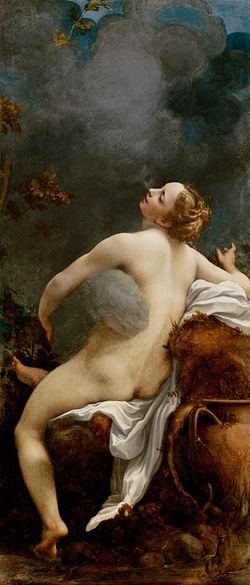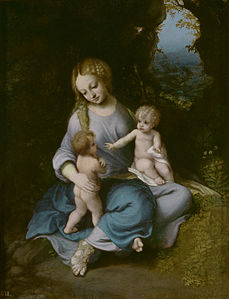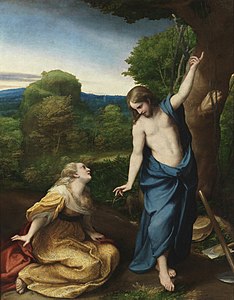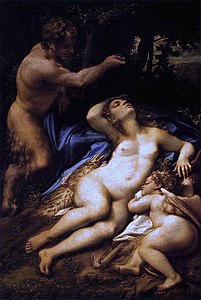Antonio da Correggio
Antonio da Correggio (actually Antonio Allegri, short Correggio or il Correggio ) (born August 1489 in Correggio , † 5. March 1534 ) was an Italian painter of the Renaissance . He worked mostly in Parma and Correggio .
Life
The birthplace of Correggio, after which he is named, is in Reggio nell'Emilia . His father was a businessman. From 1503 to 1505 Correggio was apprenticed to Francesco Bianchi Ferrara in Modena . In his earliest works, influences of classicism by artists such as Lorenzo Costa and Francesco Francia can be proven, which probably go back to this time. In 1506 Correggio was in Mantua , then he returned to Correggio, where he stayed until 1510. The adoration of the child with Elisabeth and Johannes , which seems to show influences from Costa and Mantegna, is assigned to this period of his work . In 1514 he probably completed three tondi for the entrance to St. Andrea in Mantua. After returning to his hometown, he signed, now independent and increasingly famous, a contract for an altarpiece with the Madonna in the monastery of St. Francis (1514, now in the Dresden Picture Gallery ).
In 1516 Correggio stayed in Parma, where he remained by and large from then on. Here he made friends with the mannerist Michelangelo Anselmi . In 1519 he married Girolama Francesca di Braghetis from Correggio. From this period are Madonna and Child and the young John the Baptist , Christ's Farewell to Mary and the lost Madonna of Albinea . The painting Noli me tangere (approx. 1518, according to others approx. 1522–1525), already praised by Giorgio Vasari , comes from the phase of his mature years , today in the Museo del Prado in Madrid, which finally belonged to Emperor Charles V in the Hands of King Philip IV of Spain and found its place in the sacristy of the Escorial in 1636 .
Pablo Picasso quotes Correggio's masterpiece, which he must have got to know while studying at the Llotja in Madrid, in one of the most famous works from his blue period , the painting La Vie (1903), now in the Cleveland Museum of Art , Ohio.
Correggio's first major commission was to decorate the ceiling in the private dining room of the Abbess of St. Paul in Parma (the Camera di San Paolo). Next he painted the vision of St. John in Patmos for the dome of San Giovanni Evangelista in Parma. Three years later he adorned the dome of the Parma Cathedral with a surprising shot of Mary in the sky from Melozzo's perspective (seen from below). The two works pointed to a revolutionary, illusionistic dome decoration and strongly influenced the later fresco painting ( Cignani , Ferrari , Pordenone , Lanfranco , Baciccio ), especially through the massing of the audience in a vortex, the apparent disappearance of the dome and the thrusting view up into divine infinity as encountered again in baroque painting .
style
The starting point of Correggio's art is controversial. In addition to Costa and Mantegna, it could have been shaped by Leonardo da Vinci , as well as by Michelangelo and Raphael , in essential impressions of light and dark ( Chiaroscuro ) . Around 1518 he found his own style, which combines devotional expressions with almost baroque-looking, lively movements. This explains his great impact on baroque masters like Reni , the Carracci and Barocci .
Correggio's panel paintings develop diagonal compositions, richly depict the painterly chiaroscuro and are valuable in terms of color. His frescoes are particularly characterized by the boldness of the perspective view from below, the mobility of the figures in air and light and the suggestive power of illusion.
Other works
Significant of the more than 42 extant paintings by Correggio are u. a. the
- Mystical wedding of St. Catherine of Alexandria with Christ (ca.1520),
- the Lamentation of Christ (approx. 1522),
- The Madonna of St. Sebastian (c. 1524, Dresden, Gemäldegalerie)
- the martyrdom of four saints (approx. 1524–1525),
- the Maria with the St.Jerome (Il Giorno, 1527-1528),
- the Adoration of the Shepherds (Holy Night) (La Notte, 1528–1530, Dresden, Gemäldegalerie),
- The Madonna of St. George (1530–1532, Dresden, Gemäldegalerie) and
- Jupiter and Io (1531–1532, Vienna, Kunsthistorisches Museum).
- Rest on the Flight into Egypt , around 1515, Galleria degli Uffizi Florence
Illustrations
- Works by Antonio da Correggio (selection)
Leda and the Swan, approx. 1532, Berlin, Gemäldegalerie
Individual evidence
- ^ Giorgio Vasari: Art history and art theory. An introduction to the biographies of famous artists based on the proemies. Wagenbach, Berlin 2004, ISBN 3-8031-5020-5 , p.?.
- ↑ Gereon Becht-Jördens, Peter M. Wehmeier: Picasso and Christian Iconography. Mother relationship and artistic position . Dietrich Reimer, Berlin 2003, pp. 39-45, especially p. 41; Fig. 1–4.
literature
- Corrado Ricci : Antonio Allegri da Correggio. His life and his time. Cosmos, Verlag für Kunst, Berlin 1897.
- Georg Gronau : Corregio, Antonio Allegri . In: Ulrich Thieme (Hrsg.): General Lexicon of Fine Artists from Antiquity to the Present . Founded by Ulrich Thieme and Felix Becker . tape 7 : Cioffi – Cousyns . EA Seemann, Leipzig 1912, p. 459-466 ( Text Archive - Internet Archive ).
- Lucia Fornari Schianchi: Correggio. Langewiesche, Königstein / Ts. 1994.
- Diane Degrazia: Correggio and his legacy. Sixteenth-century Emilian Drawings. National Art Gallery, Washington, DC 1984.
-
Heinrich Bodmer : Correggio and the painting of Emilia. Vienna 1942.
- Enrico Bodmer: Corregio e gli Emiliani. Istituto Geografico de Agostini, Novara 1943.
- Mario di Giampaolo, Andrea Muzzi: Correggio - The drawings. Basel 1990.
- Claudia Steinhardt-Hirsch: Correggio's “Notte”. A masterpiece of the Italian Renaissance. Deutscher Kunstverlag, Munich / Berlin 2008.
- Friedrich Wilhelm Bautz : Correggio, Antonio. In: Biographisch-Bibliographisches Kirchenlexikon (BBKL). Volume 1, Bautz, Hamm 1975. 2nd, unchanged edition Hamm 1990, ISBN 3-88309-013-1 , Sp. 1133-1134.
Web links
- Literature by and about Antonio da Correggio in the catalog of the German National Library
- Works by Antonio da Correggio at Zeno.org .
- Correggio's pictures in the Web Gallery of Art
| personal data | |
|---|---|
| SURNAME | Correggio, Antonio there |
| ALTERNATIVE NAMES | Allegri, Antonio (real name); Correggio; Corregio, Il |
| BRIEF DESCRIPTION | Italian Renaissance painter |
| DATE OF BIRTH | August 1489 |
| PLACE OF BIRTH | Correggio (Emilia-Romagna) |
| DATE OF DEATH | March 5, 1534 |
| Place of death | Correggio (Emilia-Romagna) |








